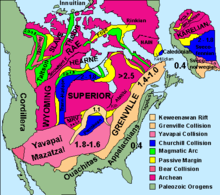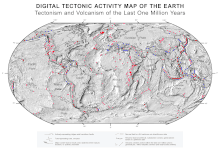From Wikipedia, the free encyclopedia
This is a list of tectonic plates on Earth. Tectonic plates are pieces of the Earth's crust and uppermost mantle, together referred to as the lithosphere. The plates are around 100 km (62 mi) thick and consist of two principal types of material: oceanic crust (also called sima from silicon and magnesium) and continental crust (sial from silicon and aluminium). The composition of the two types of crust differs markedly, with basaltic rocks ("mafic") dominating oceanic crust, while continental crust consists principally of lower density granitic rocks ("felsic"). See also Plate tectonics
Contents |
Current plates
The following tectonic plates currently exist on the Earth's surface with roughly definable boundaries.Primary plates
These seven plates comprise the bulk of the seven continents and the Pacific Ocean.- African Plate
- Antarctic Plate
- Eurasian Plate
- Indo-Australian Plate
- North American Plate
- Pacific Plate
- South American Plate
Secondary plates
These smaller plates are generally shown on major plate maps, but with the exception of the Arabian and Indian plates do not comprise significant land area.- Arabian Plate
- Caribbean Plate
- Cocos Plate
- Indian Plate
- Juan de Fuca Plate
- Nazca Plate
- Philippine Sea Plate
- Scotia Plate
Tertiary plates
Tertiary plates are grouped with the major plate that they would otherwise be shown as part of on a major plate map. Mostly these are tiny microplates, although in the case of the Nubian-Somalian and Australian-Capricorn-Indian plates these are major plates that are rifting apart. Some models identify more minor plates within current orogens like the Apulian, Explorer, Gorda, and Philippine Mobile Belt plates. The remainder of the tertiary plates are the dwindling remains of much larger ancient plates. There may or may not be scientific consensus as to whether a tertiary plate is a separate plate yet, is still a separate plate, or should be considered a separate plate, thus new research could change this list.[1][2][3][4]- African Plate
- Antarctic Plate
- Caribbean Plate
- Cocos Plate
- Eurasian Plate
- Indo-Australian Plate
- Juan de Fuca Plate
- North American Plate
- Pacific Plate
- Philippine Sea Plate
- South American Plate
Ancient continental formations
In the history of Earth many tectonic plates have come into existence and have over the intervening years either accreted onto other plates to form larger plates, rifted into smaller plates, or have been crushed by or subducted under other plates (or have done all three).Ancient supercontinents
A supercontinent is a landmass consisting of multiple continental cores. The following list includes the supercontinents known or speculated to have existed in the Earth's past:- Columbia
- Euramerica
- Gondwana
- Kenorland
- Laurasia
- Nena
- Pangaea
- Pannotia
- Proto-Gondwana
- Proto-Laurasia
- Rodinia
- Ur
- Vaalbara
Ancient plates and cratons
Not all plate boundaries are easily defined, this is especially true for ancient pieces of crust. The following list of ancient cratons, microplates, plates, shields, terranes, and zones no longer exist as separate plates. Cratons are the oldest and most stable parts of the continental lithosphere and shields are the exposed area of a craton(s). Microplates are tiny tectonic plates, terranes are fragments of crustal material formed on one tectonic plate and accreted to crust lying on another plate, and zones are bands of similar rocks on a plate formed by terrane accretion or native rock formation. Terranes may or may not have originated as independent microplates since a terrane may not contain the full thickness of the lithosphere.African plate
- Atlantica
- Bangweulu Block (Zambia)
- Congo Craton (Angola, Cameroon, Central African Republic, Democratic Republic of Congo, Gabon, Sudan, and Zambia)
- Kaapvaal Craton (South Africa)
- Kalahari Craton (South Africa)
- Saharan Craton (Algeria)
- Sebakwe proto-Craton (Zimbabwe)
- Tanzanian Craton (Tanzania)
- West African Craton (Algeria, Benin, Burkina Faso, Côte d'Ivoire, Gambia, Ghana, Guinea, Guinea Bissau, Liberia, Mali, Mauritania, Morocco, Senegal, Sierra Leone, and Togo)
- Zaire Craton (Congo)
- Zimbabwe Craton (Zimbabwe)
Antarctica plate
Eurasian plate
- Armorica (France, Germany, Spain and Portugal)
- Avalonia (Canada, Great Britain, and United States)
- Baltic Plate (Russia)
- Belomorian Craton
- Central Iberian Plate (Spain)
- Cimmerian Plate (Anatolia, Iran, Afghanistan, Tibet, Indochina and Malaya)
- East China Craton (China)
- East European Craton (Russia and Scandinavia)
- Fennoscandian Shield (Norway, Sweden, and Finland)
- Junggar Plate (China)
- Hunic plate
- Karelian Craton (Finland and Russia)
- Kazakhstania (Khazakhstan)
- Kola Craton (northwest Russia)
- Lhasa Plate
- Londen-Brabant Plate (Great Britain, Ireland, and Germany)
- Massif Central
- Moldanubian Plate (Austria)
- Moravo Silesian Plate (Czech Republic)
- Midland Craton (Great Britain)
- North Atlantic Craton
- North China Craton (China and Korea)
- Ossa-Morena Plate (Spain)
- Piemont-Liguria Plate
- Proto-Alps Terrane (Austria)
- Rhenohercynian Plate
- Sarmatian Craton (Ukraine)
- Sarmatian Craton
- Saxothuringian Plate
- Siberian Craton (Russia)
- South Portuguese Plate (Portugal)
- Tarim Craton (China)
- Teplá-Barrandian Terrane (Czech Republic)
- Ukrainian Shield (Ukraine)
- Valais Plate
- Volgo-Uralian Craton, (Russia)
- Yakutai Craton, eastern (Russia)
- Yangtze Craton (China)
Indo-Australian plate
- Altjawarra Craton (Australia)
- Bhandara Craton, (India)
- Bundelkand Craton, (India)
- Dharwar Craton, (India)
- Central Craton (Australia)
- Curnamona Craton (Australia)
- Gawler Craton (Australia)
- Indian Craton (India)
- Narooma Terrane (Australia)
- Pilbara Craton (Australia)
- Singhbhum Craton (India)
- Yilgarn Craton (Australia)
- Western Australian Shield (Australia)
- Zealandia, see Moa Plate and Lord Howe Rise (New Zealand)
North American plate

North American Cratons and basement rocks.
- Avalonia (Canada, Great Britain, and United States)
- Carolina Plate
- Churchill Craton (Canada)
- Farallon Plate (split into the Cocos, Explorer, Juan de Fuca, Gorda Plates, Nazca Plate, and Rivera Plates)
- Florida Plate (United States)
- Hearne Craton (Canada)
- Laurentian Craton (Canada and United States)
- Insular Plate
- Intermontane Plate
- Izanagi Plate
- Mexican Plate (Mexico)
- Nain province (Canada)
- Newfoundland Plate (Canada)
- Nova Scotia Plate
- Rae Craton (Canada)
- Sask Craton (Canada)
- Sclavia Craton (Canada)
- Slave Craton (Canada)
- Superior Craton (Canada)
- Wyoming Craton (United States)





No comments:
Post a Comment